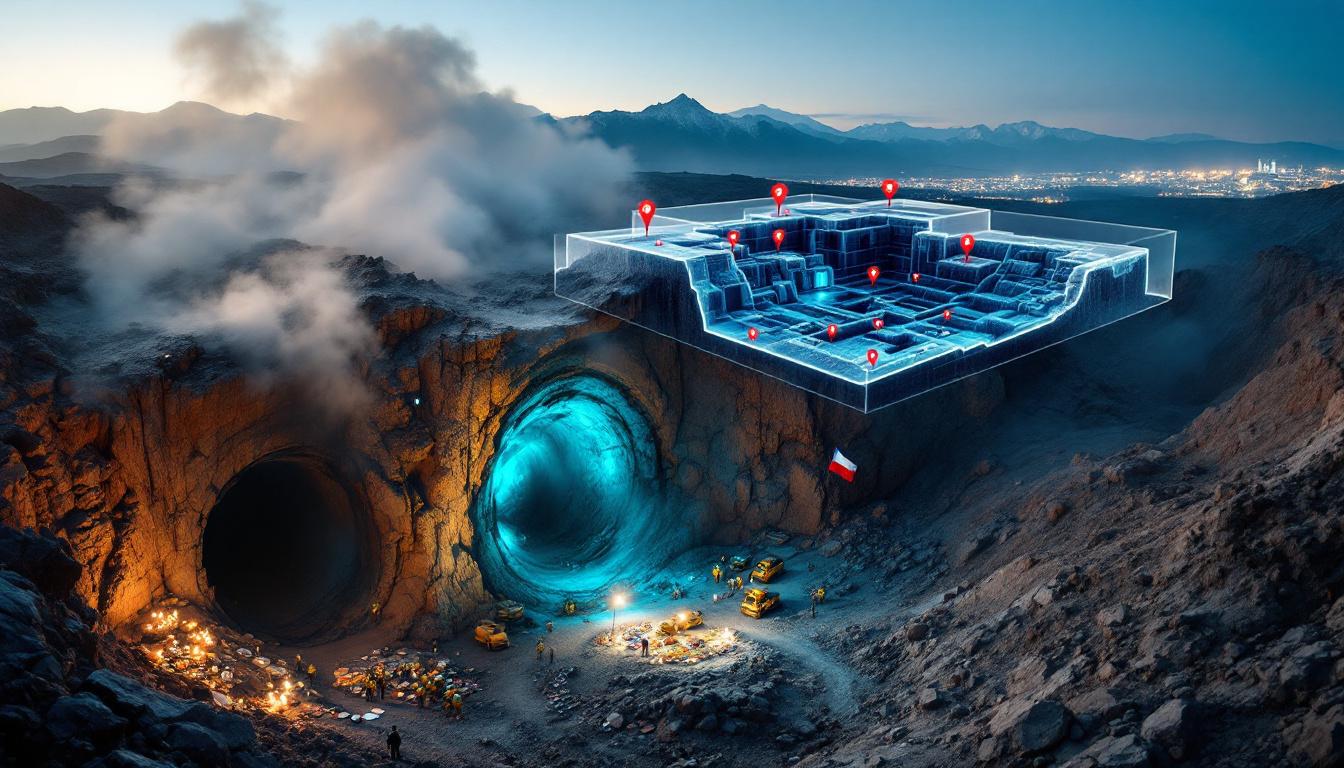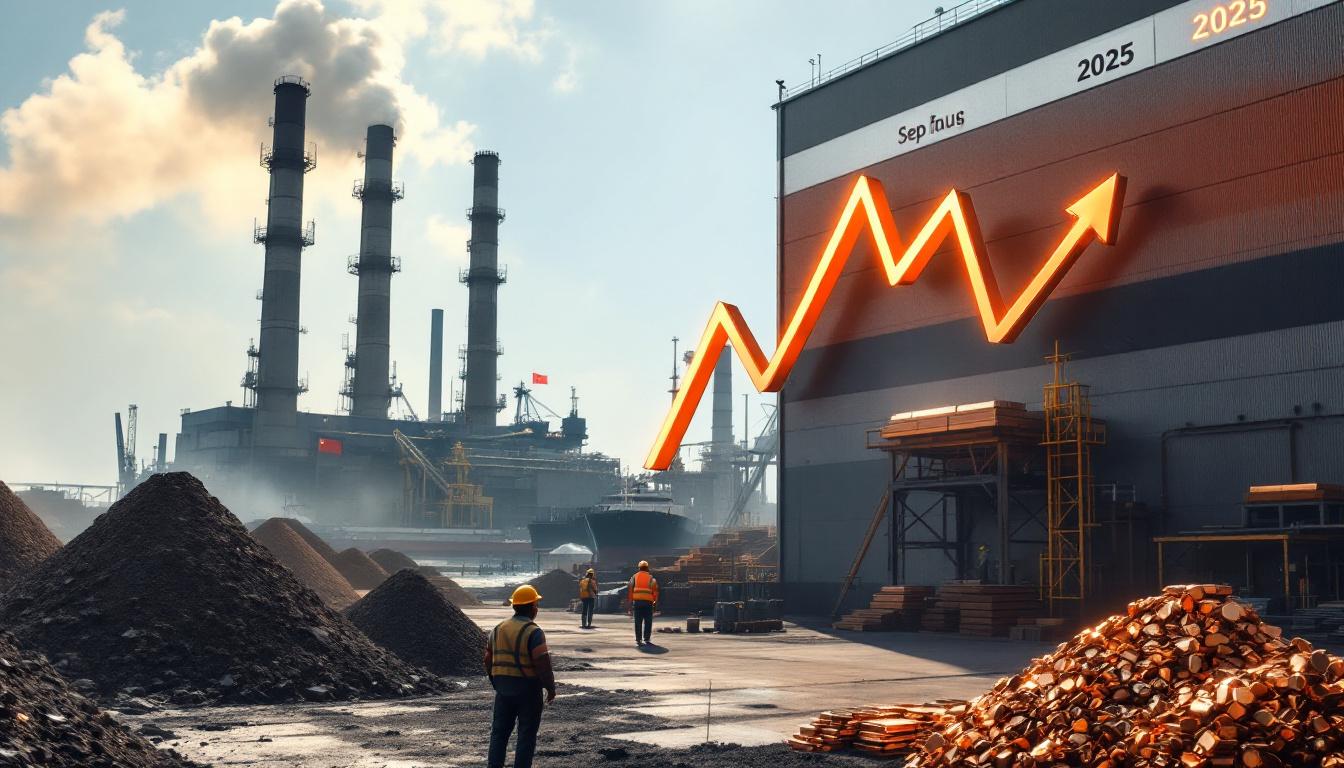Why Did Hochschild Mining's Stock Crash?
Hochschild Mining experienced a dramatic 20% share price plunge on June 10, 2025, representing the company's steepest one-day decline since November 2021. Shares dropped to 242p following the announcement of a six-week shutdown at its Mara Rosa gold mine in Brazil. This severe market reaction came after significantly lower-than-expected gold production forced the company to temporarily halt operations to reevaluate and identify critical bottlenecks.
The unexpected shutdown announcement shocked investors who had been counting on Mara Rosa as a key growth asset in Hochschild's portfolio. Market analysts noted that the severity of the drop reflects not just immediate production concerns, but deeper questions about management's ability to forecast and manage operational challenges at new mining sites.
The Production Shortfall
The Mara Rosa mine, which only began commercial production in early 2024, has produced just over 25,000 ounces of gold from January through May 2025. This falls dramatically short of the company's annual production guidance of 94,000 to 104,000 ounces for the year, representing only about 25% of the expected output for this period when prorated.
To put this shortfall into perspective, the mine was expected to produce approximately 40,000-45,000 ounces during these five months, meaning actual production is roughly 40% below target. This significant underperformance triggered immediate investor concern and contributed to the subsequent market reaction.
Factors Behind the Underperformance
Several key factors contributed to the production shortfall at the Mara Rosa operation:
- Heavier-than-expected rainfall disrupting mining operations in the open-pit environment
- Persistent contractor issues affecting operational efficiency and continuity
- Processing bottlenecks limiting throughput capacity at the plant
- Technical ramp-up challenges common to mines in their first year of commercial production
Mining engineer and industry consultant Dr. Maria Santos explained that "open-pit gold mining operations in Brazil are particularly vulnerable to seasonal rainfall variations, which can flood access roads and create unsafe working conditions. When combined with processing plant bottlenecks, these issues compound exponentially."
Geological factors specific to the Mara Rosa deposit may have also played a role in the underperformance. The mine's ore body has shown greater variability in mineral composition than initially modeled, creating unexpected challenges in processing efficiency and gold market performance.
What Will Happen During the Shutdown?
Hochschild Mining has announced a comprehensive six-week shutdown to address the operational issues plaguing the Mara Rosa mine. This decision represents a significant and unusual step for a mining company, as most operations prefer to continue producing at reduced capacity while implementing improvements.
The willingness to completely halt production signals the severity of the issues and suggests management believes the problems require fundamental operational redesign rather than incremental adjustments. This approach, while costly in the short term, could potentially deliver more sustainable long-term improvements.
Comprehensive Operational Review
During the six-week shutdown, Hochschild Mining plans to conduct a thorough review of all aspects of the Mara Rosa operation, including:
- Mining processes to improve extraction efficiency and sequence optimization
- Processing systems to eliminate bottlenecks and increase throughput
- Disposal activities to ensure environmental compliance and operational continuity
- Contractor relationships to address previous performance issues and establish clearer accountability measures
- Water management systems to better handle seasonal rainfall variations
According to analysts at Peel Hunt, the shutdown aims to create "a more flexible pit, aligned to a debottlenecked plant, allowing more stable throughput and more reliable output." This suggests the company is focusing on fundamental operational improvements rather than quick fixes.
Expected Outcomes
The operational review is expected to yield several critical outcomes:
- Revised mining plan that better accounts for seasonal weather patterns
- Upgraded processing capacity through targeted equipment modifications
- Improved contractor performance through restructured agreements
- Enhanced operational flexibility to respond to variable ore characteristics
- More realistic production forecasts based on demonstrated capabilities
Mining industry consultant James Rodriguez notes that "debottlenecking exercises typically focus on identifying the weakest links in the production chain, which often aren't obvious until a mine has been operating for several months. The investment in a proper shutdown and review can yield 15-25% throughput improvements when implemented correctly."
How Will This Impact Hochschild's Annual Production?
The six-week shutdown will significantly impact Hochschild's annual gold production from Mara Rosa, forcing substantial revisions to the company's 2025 guidance. While the initial financial impact is severe, the long-term implications depend entirely on whether the operational review successfully addresses the underlying issues.
Revised Production Estimates
The shutdown will significantly impact Hochschild's annual gold production from Mara Rosa:
| Original 2025 Guidance | Peel Hunt Revised Estimate | Reduction |
|---|---|---|
| 94,000-104,000 oz | 60,000 oz | ~36-42% |
This substantial reduction in expected output explains the severe market reaction, as investors adjust their valuation models to account for lower revenue projections. At current gold prices analysis of approximately $2,100 per ounce, this production shortfall represents potential lost revenue of $71.4-$92.4 million.
Financial Impact Assessment
The financial implications extend beyond just lost production:
- Direct shutdown costs estimated at $4-6 million for maintenance, consulting, and idle labor
- Cash flow reduction of approximately $75-95 million from lost gold sales
- Potential contract penalties with refiners and buyers expecting consistent supply
- Additional capital expenditure requirements for processing plant modifications
The severity of this impact is particularly concerning given that Mara Rosa was expected to contribute approximately 35% of Hochschild's total gold production for 2025, based on the company's previous guidance.
"The timing of this shutdown is particularly unfortunate given the current strength in gold prices," notes commodity analyst Sarah Chen. "At $2,100 per ounce, every day of lost production represents a significant opportunity cost that cannot be recovered."
What Does This Mean for Investors?
The immediate 20% drop in Hochschild's share price reflects the market's reaction to both the production shortfall and the uncertainty surrounding the mine's future performance. Investors must now evaluate whether this represents a buying opportunity or a warning sign of deeper problems.
Short-Term Implications
The immediate 20% share price drop reflects:
- Lost production during the six-week shutdown period
- Reduced annual output expectations by up to 42%
- Uncertainty about the mine's ability to reach target production levels
- Cash flow concerns from lower gold sales at a time of strong gold prices
- Questions about management's operational oversight and initial production forecasting
The company's market capitalization has declined by approximately $230 million following the announcement, reflecting investors' immediate reassessment of Hochschild's value proposition.
Long-Term Considerations
While the shutdown represents a significant short-term setback, investors should consider:
- Remediation potential – Will the operational review lead to sustainable improvements?
- Problem depth – Are the production issues temporary or indicators of deeper structural problems?
- Management credibility – How does this affect confidence in leadership's operational expertise?
- Gold price environment – Will continued strength in gold price forecast offset some production losses?
- Track record – How has Hochschild handled similar challenges at other operations?
Investment analyst Miguel Torres suggests that "investors should look closely at Hochschild's capital allocation strategy and technical expertise. The Mara Rosa issues may indicate broader organizational challenges in project planning and operational management that could affect other assets in their portfolio."
For long-term investors, the key question remains whether this represents a one-time correction or signals more persistent issues with Hochschild's project management capabilities and technical execution.
How Does This Compare to Other Mining Setbacks?
Production challenges at new mines are not uncommon in the gold mining sector, but the magnitude and management response at Mara Rosa make this case particularly noteworthy. Understanding the broader industry context helps investors evaluate whether Hochschild's issues are company-specific or reflect industry-wide challenges.
Industry Context
Several factors make the Mara Rosa situation stand out compared to typical mining setbacks:
- The mine only recently entered commercial production (early 2024)
- The production shortfall is substantial (approximately 75% below the prorated annual target)
- The decision to completely halt production rather than continue at reduced rates
- The timing coincides with near-record gold prices, amplifying the opportunity cost
Similar cases in the industry include Lundin Mining's Candelaria operation, which underwent a shorter two-week shutdown in 2023 to address process plant issues, and Equinox Gold's Castle Mountain Mine, which faced ramp-up challenges in 2022 but continued operations at reduced capacity.
Risk Factors for New Mines
The Mara Rosa situation highlights common risk factors for recently commissioned mining operations:
- Weather vulnerability – especially in regions with seasonal rainfall patterns
- Contractor dependencies – reliance on third parties for critical operations
- Ramp-up challenges – difficulty achieving design capacity in early production phases
- Technical bottlenecks – unforeseen limitations in processing systems
- Ore variability – differences between resource models and actual mining conditions
Mining engineer Paulo Oliveira points out that "the first year of a gold mine's operation often reveals discrepancies between geological models and actual ore body characteristics. These discrepancies can cascade through the entire production chain, affecting everything from extraction rates to processing recovery."
"What makes Hochschild's situation unusual is not the existence of problems, but the decision to fully shut down rather than implement fixes while maintaining reduced production," notes industry analyst Robert Chang. "This suggests either extraordinary confidence in their ability to quickly resolve issues or deeper problems than initially disclosed."
What's Next for Hochschild Mining?
Hochschild Mining faces a critical period that will test both management's technical capabilities and their communication skills with investors. The success of the operational review and subsequent restart will likely determine the company's medium-term trajectory and investor confidence.
Critical Success Factors
For Hochschild to recover investor confidence, several key milestones will be important:
- Successful completion of the operational review within the stated timeframe
- Clear communication of identified issues and remediation plans
- Demonstrated improvement in production rates after the shutdown
- Revised guidance that proves achievable in subsequent quarters
- Transparent disclosure of any additional capital requirements
The company will need to strike a delicate balance between transparency about the challenges and confidence in their solutions. Past mining industry evolution shutdowns suggest that companies providing detailed explanations of technical issues and specific remediation plans tend to recover investor confidence more quickly.
Potential Outcomes
Analysts will be closely watching for:
- Revised annual production guidance following the shutdown
- Capital expenditure requirements for any necessary modifications
- Timeline projections for reaching full production capacity
- Impact assessment on the mine's overall economic viability
- Management changes if the issues are deemed to reflect broader organizational problems
According to mining industry consultant Elena Rodriguez, "The critical metrics to watch after restart will be daily throughput tons, recovery rates, and most importantly, consistency in performance. If these metrics show stability after the first month of resumed operations, it would signal successful remediation."
The six-week timeframe provides Hochschild with a narrow window to address complex operational issues. Industry precedent suggests that successful turnarounds of this nature typically require 3-6 months to fully implement and demonstrate sustainable results.
FAQ: Hochschild Mining's Mara Rosa Shutdown
When did Mara Rosa begin commercial production?
Mara Rosa began commercial production in early 2024, making it a relatively new operation in Hochschild's portfolio.
What was the original production guidance for Mara Rosa in 2025?
Hochschild had projected 94,000 to 104,000 ounces of gold production from Mara Rosa for 2025.
How much gold did Mara Rosa produce before the shutdown?
The mine produced just over 25,000 ounces of gold from January through May 2025.
What are the main reasons for the production shortfall?
Heavier-than-expected rainfall, contractor issues, processing bottlenecks, and typical ramp-up challenges for a new mine were cited as the primary causes for the underperformance.
How long will the operational shutdown last?
Hochschild announced a six-week shutdown to conduct a comprehensive review of mining, processing, and disposal activities.
Will this affect Hochschild's overall financial stability?
While the shutdown represents a significant revenue loss, analysts generally believe the company's balance sheet remains strong enough to weather this temporary setback.
Are there environmental or regulatory issues involved?
No environmental or regulatory violations have been cited as reasons for the shutdown, though the operational review will include an assessment of disposal activities to ensure continued compliance.
How does this compare to Hochschild's performance at other mines?
Hochschild's other operations, particularly its Peruvian assets, have historically demonstrated more stable production profiles, making the Mara Rosa issues somewhat anomalous for the company.
Hochschild Mining's Path Forward After Brazil Mine Shutdown
The dramatic 20% plunge in Hochschild Mining's share price reflects serious investor concerns about the Mara Rosa gold mine's ability to meet production targets. While the six-week shutdown represents a significant short-term setback, it may provide the necessary opportunity to address fundamental operational issues.
The coming months will be critical for Hochschild as they work to implement the findings from their operational review. Success will depend not only on identifying the correct technical solutions but also on rebuilding investor confidence through transparent communication and consistent execution.
Industry experience suggests that mines facing similar early-stage operational challenges can recover and achieve design capacity, but typically require additional time and capital beyond initial projections. Investors should watch closely for signs of sustainable improvement in throughput and recovery rates when operations resume.
"The gold mining industry has numerous examples of successful turnarounds following initial operational challenges," notes mining analyst Jennifer Walsh. "The key differentiator is usually management's willingness to make fundamental changes rather than incremental adjustments."
For Hochschild Mining, the Mara Rosa shutdown represents both a significant challenge and an opportunity to demonstrate operational excellence. Their response in the coming months will likely shape investor perception of the company for years to come, particularly regarding their investment strategies in gold.
Disclaimer: This article contains analysis of a mining company's operational challenges and potential financial impacts. The information presented is based on current data and expert analysis but involves inherent uncertainty about future outcomes. Investors should conduct their own due diligence before making investment decisions based on this information.
Want to Spot the Next Major Mining Discovery Before the Market Does?
Discover how real-time alerts powered by Discovery Alert's proprietary Discovery IQ model can help you capitalise on significant ASX mineral discoveries as soon as they're announced. Explore our dedicated discoveries page to understand how early investors in major discoveries like De Grey Mining and WA1 Resources secured exceptional returns.




